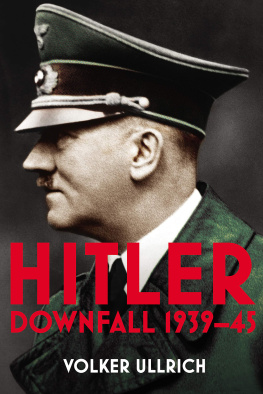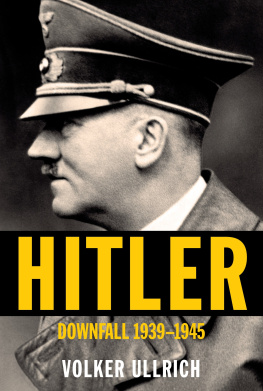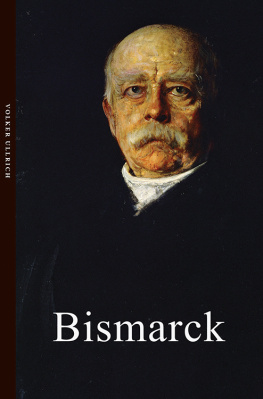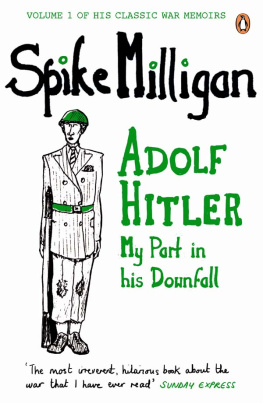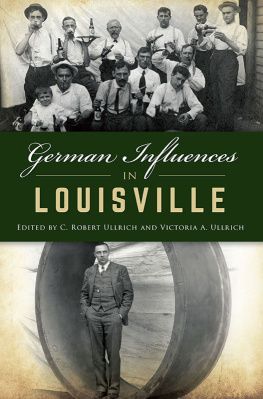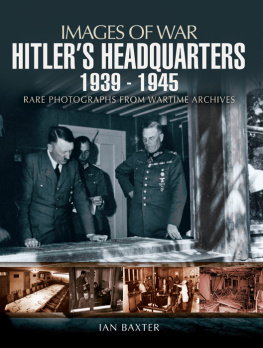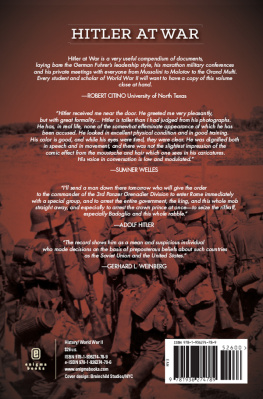Volker Ullrich - Hitler: Volume II: Downfall 1939-45
Here you can read online Volker Ullrich - Hitler: Volume II: Downfall 1939-45 full text of the book (entire story) in english for free. Download pdf and epub, get meaning, cover and reviews about this ebook. year: 2020, publisher: Penguin Books Ltd, genre: Non-fiction. Description of the work, (preface) as well as reviews are available. Best literature library LitArk.com created for fans of good reading and offers a wide selection of genres:
Romance novel
Science fiction
Adventure
Detective
Science
History
Home and family
Prose
Art
Politics
Computer
Non-fiction
Religion
Business
Children
Humor
Choose a favorite category and find really read worthwhile books. Enjoy immersion in the world of imagination, feel the emotions of the characters or learn something new for yourself, make an fascinating discovery.
- Book:Hitler: Volume II: Downfall 1939-45
- Author:
- Publisher:Penguin Books Ltd
- Genre:
- Year:2020
- Rating:5 / 5
- Favourites:Add to favourites
- Your mark:
- 100
- 1
- 2
- 3
- 4
- 5
Hitler: Volume II: Downfall 1939-45: summary, description and annotation
We offer to read an annotation, description, summary or preface (depends on what the author of the book "Hitler: Volume II: Downfall 1939-45" wrote himself). If you haven't found the necessary information about the book — write in the comments, we will try to find it.
Hitler: Volume II: Downfall 1939-45 — read online for free the complete book (whole text) full work
Below is the text of the book, divided by pages. System saving the place of the last page read, allows you to conveniently read the book "Hitler: Volume II: Downfall 1939-45" online for free, without having to search again every time where you left off. Put a bookmark, and you can go to the page where you finished reading at any time.
Font size:
Interval:
Bookmark:


Volker Ullrich is a historian and journalist whose previous books include biographies of Bismarck and Napoleon, as well as a major study of Imperial Germany, The Nervous Superpower 18711918. From 1990 to 2009, Ullrich was the editor of the Political Book review section of the influential weekly newspaper, Die Zeit. On publication in Germany in 2013, Hitler: Ascent 18891939 became a top ten bestseller.
Hitler with Ribbentrop in Poland, 13 September 1939 (Bayerische Staatsbibliothek Mnchen/Bildarchiv).
Georg Elser after his arrest (Bayerische Staatsbibliothek Mnchen/Bildarchiv).
The triumphant Hitler in his Wolfs Ravine headquarters, 17 June 1940 (ullstein bild/Walter Frentz).
Mnchen/Bildarchiv).
Hitler promoting his generals, 14 August 1940 (ullstein bild/Sddeutsche Zeitung).
Hitlers order for Operation Barbarossa, 18 December 1940 (Bundesarchiv RM 7/962, Bl. 209).
Hitler and his court in the Wolfs Lair headquarters, 24 June 1941.
German troops invading the Soviet Union (Bildarchiv Preussischer Kulturbesitz).
in the early stages of Operation Barbarossa (Bundesarchiv 183-B21845/Wahner).
Team of horses struggling through the mud at Kursk, March 1942 (Bundesarchiv 101 I-289-1091-26/Dinsthler).
Hitlers euthanasia order, backdated to 1 September 1939.
Site of the Babi Yar massacre, October 1940.
).
German Jews from Wrzburg being transported east, 25 April 1942 (Staatsarchiv Wrzburg, Gestapo 18880a, Foto 114).
Hungarian Jews deported to Auschwitz-Birkenau, MayJuly 1944 (ullstein bild).
The German Reichstag convenes for the last time, 26 April 1942 (SZ Bildarchiv, Scherl/Sddeutsche Zeitung Photo).
Bilderdienst).
Goebbels delivers his Do you want total war? speech in the Sportpalast, 18 February 1943 (Bundesarchiv 183-JO5235/Ernst Schwahn).
German soldier embarking on home leave, December 1941 (Bundesarchiv 183-B14051/Schmidt).
Hitler and Goebbels on the Obersalzberg, June 1943 (ullstein bild/Walter Frentz).
Normandy, 6 June 1944 (ullstein bild).
War material left behind by the German 9th Army during Operation Bagration, July 1944.
German POWs are paraded through Moscow, 17 July 1944 (picture-alliance/RIA Novosti).
Evening society in the Berghofs Great Hall, May 1944 (ullstein bild/Walter Frentz).
May 1942.
Hitler and Himmler on the Obersalzberg, 3 April 1944 (ullstein bild/Walter Frentz).
Hitler with Stauffenberg in the Wolfs Lair, 15 July 1944 (ullstein bild).
Hitler with Mussolini in the destroyed situation room, 20 July 1944 (Bundesarchiv 146-1969-071A-03).
Hitler delivering his radio address after the assassination attempt, 20 July 1944 (ullstein bild).
Hitlers final New Years reception in his Eagles Nest headquarters, 1 January 1945 (SZ Bildarchiv, Sammlung Megele/Sddeutsche Zeitung Photo).
The aged dictator with magnifying glass (ullstein bild/Heinrich Hoffmann).
East Prussian refugees crossing the frozen Vistula Lagoon, early January 1945 (ullstein bild).
(ullstein bild).
Situation meeting in Harnekop Palace, 3 March 1945 (ullstein bild).
Hitlers final public appearance, receiving Hitler Youth members in the Chancellery garden, 20 March 1945 (Bayerische Staatsbibliothek Mnchen/Bildarchiv).
Hitler inspecting the damage to the New Reich Chancellery, late March 1945 (Bayerische Staatsbibliothek Mnchen/Bildarchiv).
Every effort has been made to trace and contact copyright-holders. The publishers will be pleased to correct any mistakes or omissions in future editions.
The first volume of this biography concerned Hitlers time of ascent. It described how an obscure private in the First World War worked his way up in the 1920s to become the undisputed leader, the Fhrer, of the racist and nationalist right in Germany; how he got hold of the levers of power thanks to an alliance with conservative elites in January 1933; and how after establishing his dictatorship, he dismantled the Treaty of Versailles piece by piece, gradually moving from a politics of revision to a politics of expansion. That part of Hitlers story concluded with his fiftieth birthday celebrations, replete with enormous pomp, on 20 April 1939. At the time, his meteoric rise seemed unstoppable. Yet, as a number of acute contemporary observers recognised, his fall had already begun. Nemesis was knocking at his door.
The second volume of this biography covers Hitlers years of downfall. It encompasses the relatively brief period from his unleashing of the Second World War in the summer of 1939 to his suicide in the air-raid bunker of the Reich Chancellery in the spring of 1945. It has been said, correctly, that Hitler and National Socialism found themselves in possible, the whole European continent. On the other hand, as we will see, Hitler would never have been able to realise these goals as much as he did without willing helpers in almost all the institutions of the Nazi state and broad parts of German society.
In war, we see Hitler in a new role, that of a military commander. After Germanys unexpectedly swift victory over France in May and June
In their post-1945 memoirs, Germanys generals rejected any responsibility for the countrys military defeat. The war could have been One obvious function of that narrative of the strategically incompetent Fhrer, divorced from all reality, was to exonerate people like Halder himself. Blaming Hitler alone for all mistakes removed the need to discuss ones own shortcomings. Yet Hitler was not at all as incompetent in military matters as the German military leadership claimed after 1945.
The course of the Second World War directly reflected the man who started it. Hitlers hostile personality and conviction that Germany needed additional living space made war inevitable, and at the start of the conflict, his tendency to go for broke and act in surprising and outrageous ways worked astonishingly well on the battlefield. Those same qualities, however, also proved his undoing because they led him to overstretch himself there is no way to understand the key moments in the conflict, Operation Barbarossa and declaring war on the United States, except as consequences of Hitlers personality. Meanwhile, his role as field commander gradually overwhelmed him so that he could no longer call upon useful traits such as strategic flexibility or ruthless realism. And once things began going wrong, they rapidly spiralled out of control, as Hitlers alternately hot-headed and intransigent responses constantly dismissing his military professionals, ruling out tactical retreats only made the situation worse. By the conclusion of the war, the catastrophe he wreaked on Germany, with the support of the German people, was mirrored by the physical and psychological catastrophe he wreaked on himself. Germany ended up in ruins, just as its Fhrer ended his life as a complete wreck.
Next pageFont size:
Interval:
Bookmark:
Similar books «Hitler: Volume II: Downfall 1939-45»
Look at similar books to Hitler: Volume II: Downfall 1939-45. We have selected literature similar in name and meaning in the hope of providing readers with more options to find new, interesting, not yet read works.
Discussion, reviews of the book Hitler: Volume II: Downfall 1939-45 and just readers' own opinions. Leave your comments, write what you think about the work, its meaning or the main characters. Specify what exactly you liked and what you didn't like, and why you think so.

